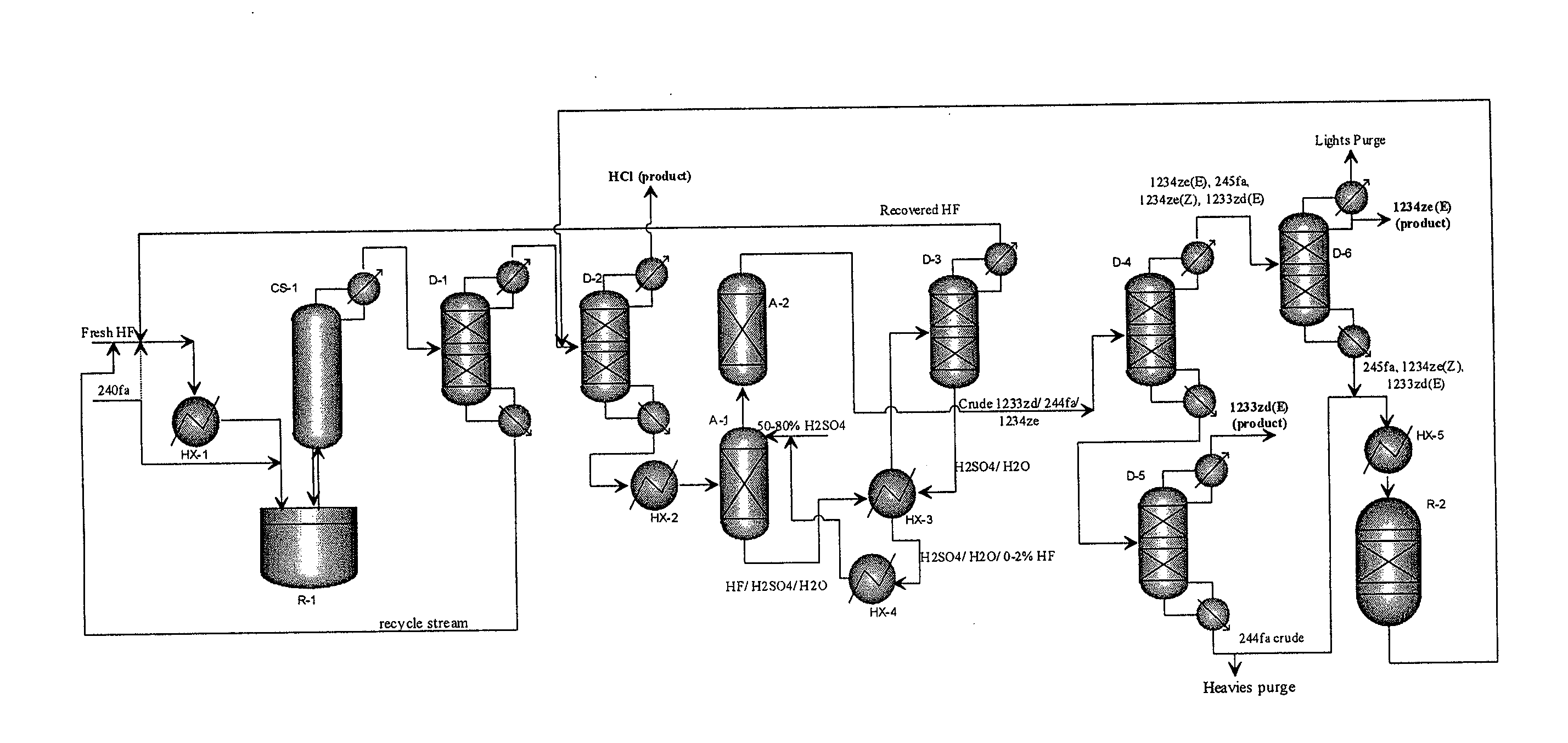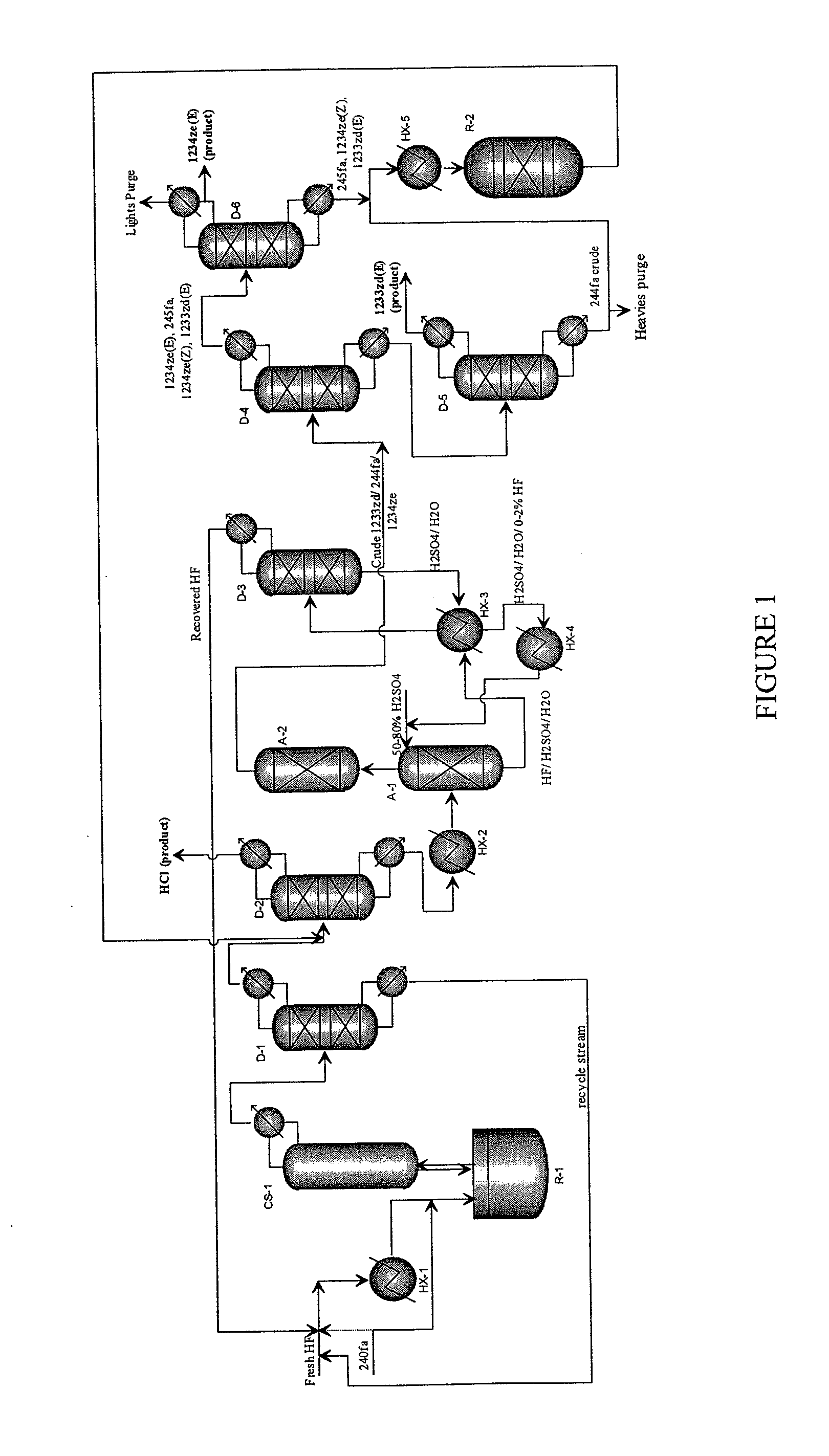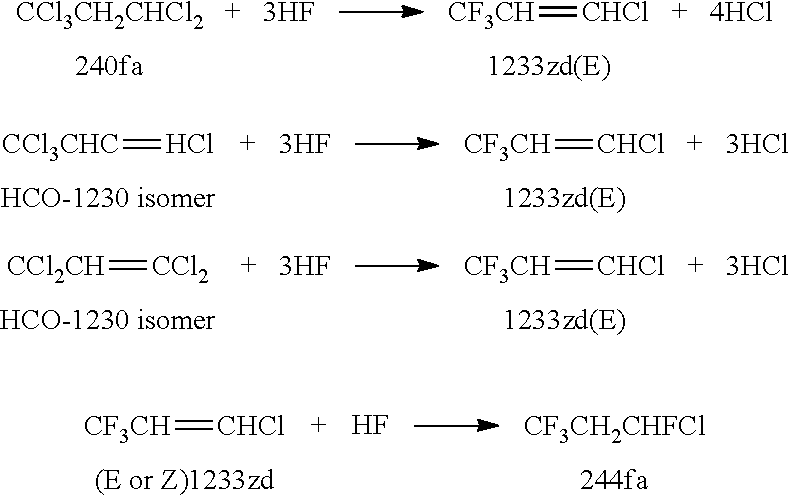Integrated Process to Co-Produce Trans-1-Chloro-3,3,3-Trifluoropropene and Trans-1,3,3,3-Tetrafluoropropene
a technology of trifluoropropene and trans-1,3,3,3-tetrafluoropropene, which is applied in the field of integrated process to co-produce trans-1,3,3,3-tetrafluoropropene, and achieves the effect of cost saving
- Summary
- Abstract
- Description
- Claims
- Application Information
AI Technical Summary
Benefits of technology
Problems solved by technology
Method used
Image
Examples
example 1
[0074]This example illustrates the continuous reaction where HCC240fa is continuously fed into a charge of Titanium halide catalyst and HF.
[0075]A clean, empty 10-gallon jacketed, agitated reactor of Hastelloy C construction was prepared. This reactor is connected to a 2 inch diameter vertical, PTFE-lined pipe containing packing material (stripper), which is in turn connected to an overhead heat exchanger. The heat exchanger is supplied with −40° C. brine circulation on the shell side. Vapors exiting this stripper are processed through a scrubber, in which temperature-controlled dilute potassium hydroxide aqueous solution is circulated. Vapors exiting this stripper are collected in a weighed, chilled (−40° C.) cylinder, followed by a smaller cylinder in series chilled in a dry ice bath.
[0076]Initially about 1200 grams of TiCl4 was added as a catalyst, followed immediately by 28 pounds of HF. The reactor contents were heated to about 85° C. while agitated and was at a pressure of 120...
example 2
[0077]This example illustrates the semi-batch reaction where HCC240fa is continuously fed into a charge of Titanium halide catalyst and HF.
[0078]The same reactor as in Example 1 was used. The reactor was charged with 2600 grams of fresh TiCl4 catalyst.
[0079]The process (reaction of HCC-240+HF in the presence of TiCl4 catalyst) was changed from a completely batch process to a semi-continuous process with the hopes of reducing the residence time of the G240 in the reactor and thereby reducing the formation of the over fluorinated species, 244fa. The reactor was initially charged with 50 pounds of HF followed by 13 pounds of G240 and the reactor temperature was slowly increased and reaction was observed at a temperature in the range of from about 80° to 85° C. The reaction was allowed to proceed for a couple of hours with the lighter components continuously being taken overhead of the catalyst stripper column to the scrubber and product collection in dry ice cold traps (DITs).
[0080]The...
example 3
[0082]This Example is 244fa dehydrohalogenation over metal chloride catalysts.
[0083]In Example 3, a series of mono-, bi-, and tri-valent metal chlorides were used as dehydrohalogenation catalysts, in which 20 ml of catalyst was used. 244fa was passed over each catalyst at a rate of 12 g / h at a temperature of 350° C.
[0084]As shown in Table 1, all the mono- and bi-valent metal chloride catalysts provided a 1234ze(E+Z) selectivity higher than 80% and a 1233zd(E+Z) selectivity lower than 20%, indicating these catalysts are more active for 244fa dehydrochlorination than its dehydrofluorination.
[0085]In comparison, the mono-valent metal chloride catalysts are more selective to form 1234ze(E+Z) than bi-valent metal chloride ones. A 244fa conversion higher than 90% was achieved over the following catalysts: 10.0 wt % LiCl / C, 10.0 wt % KCl / C, and 10.0 wt % MgCl2 / C. On the other hand, the tri-valent iron chloride catalyst exhibited a 1234ze(E+Z) selectivity of about 9% and a 1233zd(E+Z) selec...
PUM
| Property | Measurement | Unit |
|---|---|---|
| Volume | aaaaa | aaaaa |
| Fraction | aaaaa | aaaaa |
| Fraction | aaaaa | aaaaa |
Abstract
Description
Claims
Application Information
 Login to View More
Login to View More - R&D
- Intellectual Property
- Life Sciences
- Materials
- Tech Scout
- Unparalleled Data Quality
- Higher Quality Content
- 60% Fewer Hallucinations
Browse by: Latest US Patents, China's latest patents, Technical Efficacy Thesaurus, Application Domain, Technology Topic, Popular Technical Reports.
© 2025 PatSnap. All rights reserved.Legal|Privacy policy|Modern Slavery Act Transparency Statement|Sitemap|About US| Contact US: help@patsnap.com



